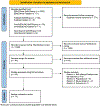Understanding the Roles of Fatalism and Self-Efficacy on Clinical and Behavioral Outcomes for African American with Type 2 Diabetes: A Systematic Review
- PMID: 40307503
- PMCID: PMC12131228
- DOI: 10.1007/s11892-025-01586-2
Understanding the Roles of Fatalism and Self-Efficacy on Clinical and Behavioral Outcomes for African American with Type 2 Diabetes: A Systematic Review
Abstract
Purpose of review: To evaluate the evidence on the relationship between fatalism, self-efficacy, and clinical and behavioral diabetes outcomes among African American adults with type 2 diabetes and to recommend areas for future work.
Recent findings: Evidence suggests that psychosocial factors including fatalism and self-efficacy are essential for optimizing diabetes outcomes and may be important considerations for reducing health disparities in type 2 diabetes. A reproducible search using OVID Medline, PubMed, and EBSCOHost was conducted from database creation up to February 2025. Medical Subject Heading terms and key words representing fatalism, self-efficacy, and diabetes were used. Outcomes included: hemoglobin A1c, LDL, Blood Pressure, Self-Care, and Quality of Life. A total of 17 studies were identified, 5 examining fatalism and 12 examining self-efficacy. All 5 fatalism studies demonstrated that fatalism is statistically significantly related to self-care behaviors and HbA1c, however this relationship may be impacted by other psychosocial and social risk factors. Among the self-efficacy studies, 11 demonstrated statistically significant relationships between self-efficacy and one or more clinical and behavioral outcomes including HbA1c, diet, physical activity, medication adherence, blood glucose testing, and quality of life. All studies were cross-sectional analyses. Given the small number of studies focused on fatalism and the largely correlational results for self-efficacy, there is a need for more targeted research to understand contributors to and moderators of the influence of the factors on outcomes.
Keywords: African American adults; Diabetes fatalism; Self-efficacy; Type 2 diabetes.
© 2025. The Author(s), under exclusive licence to Springer Science+Business Media, LLC, part of Springer Nature.
Conflict of interest statement
Declarations. Human/Animal Studies Informed Consent Statement: This article does not contain any studies with human or animal subjects performed by any of the authors. Competing Interests: The authors declare no competing interests. Prior Presentation: This work has not been presented or submitted for presentation at an annual meeting or other conference.
References
-
- World Health Organization, The Top Leading Causes of Death. 2014. Accessed from: https://www.who.int/news-room/fact-sheets/detail/the-top-10-causes-of-death
-
- Center for Disease Control and Prevention. National Diabetes Statistics Report. 2024. Accessed from: https://www.cdc.gov/diabetes/php/data-research/index.html
-
- Ong KL, Stafford LK, McLaughlin SA, Boyko EJ, Vollset SE, Smith AE, Dalton BE, Duprey J, Cruz JA, Hagins H, Lindstedt PA. Global, regional, and national burden of diabetes from 1990 to 2021, with projections of prevalence to 2050: a systematic analysis for the Global Burden of Disease Study 2021. The Lancet. 2023. Jul 15;407(10397):203–34. - PMC - PubMed
-
-
Neupane S, Florkowski WJ, Dhakal C. Trends and disparities in diabetes prevalence in the United States from 2012 to 2022. Am J Prev Med. 2024;67(2):299–302.
Disparities in prevalence of diabetes continue to persist in the US, with Non-Hispanic Black adults experiencing disproportionate burden, indicating gaps are persisting and in some subpopulations widening over time.
-
Publication types
MeSH terms
Grants and funding
LinkOut - more resources
Full Text Sources
Medical
Research Materials


